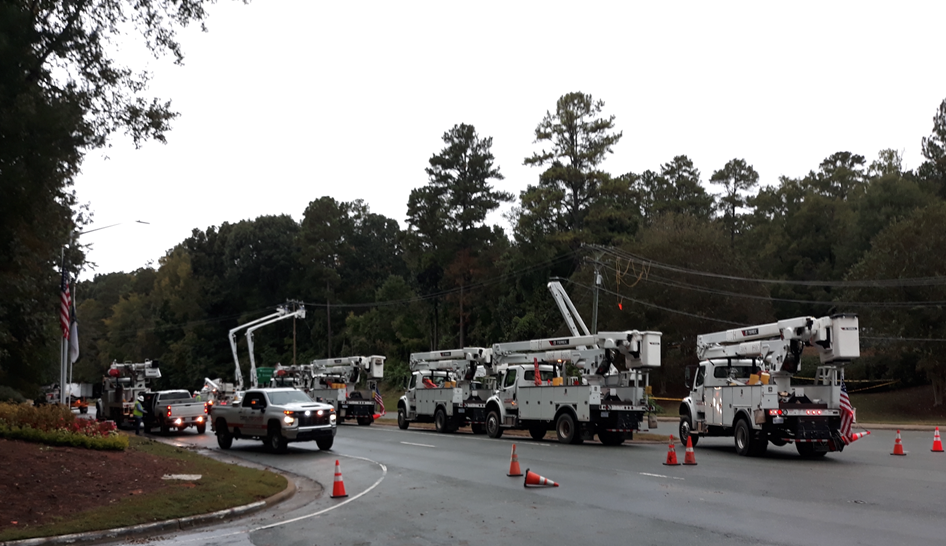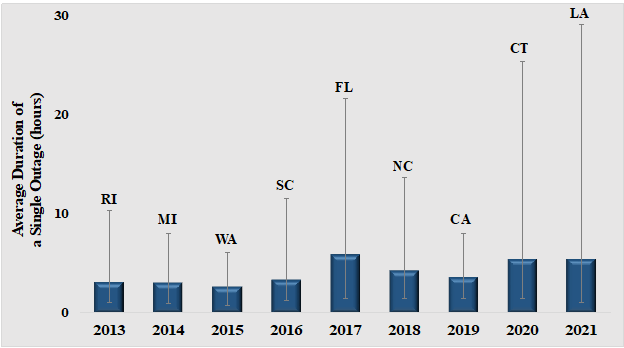
Energy Resilience Readiness: How Long Can We Survive without Electricity?
The 2023 Atlantic Hurricane Season is on.
When Hurricane Ian knocked down trees and power lines at the entrance of my apartment in October 2022, I was unexpectedly stuck at home without power. Until it was restored next day, the biggest challenge stemmed from uncertainties about “how long” I would have to remain disconnected from the grid. This day-long outage may not sound like much of a hardship, but as the hours or days add up, the impact on individuals and families can rapidly grow from an inconvenience into a significant problem. For example, food safety experts note that many kinds of food in the refrigerator should be discarded after 4 hours without power, which could have major impacts on families or those who struggle to put food on the table. Cell phone batteries last only about 10 hours on average, and cell towers themselves are also vulnerable to outages and run for a limited time on backup power during outages. As a result, communication can be disrupted in a society dependent on the internet and mobile devices. I also found myself feeling completely isolated after my cell phone and laptop died in the middle of the night.
Unfortunately, this is not merely anecdotal. Power disruptions are not uncommon as the U.S. grid infrastructure has been challenged by various threats such as extreme weather, wildlife, sabotage, and cyberattack. Last year, conventional energy generation reached its highest level of unavailability, and more than 80% of the major power outages in the U.S. between 2000 and 2021 were attributable to weather-related events. The situation is even more complicated on the West Coast. Investor-owned utilities in California and Oregon can execute an authorized service disconnection called Public Safety Power Shutoff (PSPS) as a last resort to reduce the risk of wildfires caused by electric infrastructure. In California, the average PSPS duration between 2013 and 2020 was 41 hours, with the longest 163 hours (almost a week).
Such power disruptions implicate energy reliability and resilience. Energy reliability evaluates the performance of grid infrastructure. It estimates the ability to provide uninterrupted energy supply regardless of underlying causes, and it is measured in different indices, including the Customer Average Interruption Duration Index (CAIDI), which measures the average outage duration per impacted customer. The blue bars in Figure 1 show CAIDI of the U.S. grid electricity between 2013 and 2021. The grey vertical bars represent ranges of values across different states, and the states with the longest duration for each year are indicated.

Figure 1. The U.S. Customer Average Interruption Duration from 2013 to 2021 (Data Source: U.S. Energy Information Administration).
As shown in Figure 1, there is a wide variance in the outage durations as well as in the location with the longest duration each year, which shows that no single state can be an exception for such power disruptions. Accordingly, timely and solid responses to and recovery from power disruptions along with uninterrupted energy supply are required. In this regard, it is important to achieve energy resilience. DOE defines energy resilience as “the ability to operate building energy services, such as heating, cooling, ventilation, critical plug loads, and shelter, during and in response to a major disruption.” It overlaps with energy reliability in many aspects, but it is more inclusive in terms of response and recovery capabilities.
In recognition of the importance of energy resilience, the Department of Defense (DOD), the largest energy user in the U.S., has exerted a line of effort. The National Defense Authorization Act (NDAA) for Fiscal Year 2023 directs the Secretaries of the Army, the Navy, and the Air Force to develop frameworks for the Energy Resilience Readiness Exercise (EERE) program, which would assess and demonstrate the ability to withstand 12 or more hours of commercial energy disruptions. Last year, Fort Knox, which had experienced a painful 10-day outage during the 2009 Ohio Valley Ice Storm, demonstrated its capability to completely restore its power within seven minutes of its commercial power grid being disconnected, breaking the previous record by five minutes. Although the electric power industry is also required to test the resilience readiness of its assets, large utilities are much more limited in their ability to execute exercises such as EERE in real settings. Therefore, the military’s best practices and lessons learned in real settings can provide the industry with guidance and framework.
Yet, the current 12-hour disruption clause still has room for improvement to reflect more extended power disruptions. To this end, the U.S. Army set an ambitious goal of sustaining power and water for 14 days without relying on civilian suppliers. If successfully executed, the Army’s case can serve as best practices for other military branches, federal agencies, and state and local governments.
In addition, outage emergency protocols should be developed in further detail. In comparison to natural hazards, there is a relative lack of concrete emergency plans for power disruptions, although the electric utility companies and federal agencies such as FEMA (Federal Emergency Management Agency) share general guidelines. Also, the current system which requires people to sign up for outage alerts or warning notifications necessitates more comprehensive emergency response system that would inform the population in the affected areas to ensure that no one is left behind.
Energy resilience requires collective and cooperative actions from supply, demand, and regulatory sides all together given that the U.S. grid electricity confronts various challenges, to name a few, aging infrastructure, increasing electrification, additional distributed energy resources to be connected, extreme weather events (with more numbers of low-frequency, but high-impact events), as well as climate change. General Omar Bradley said, “Amateurs talk strategy. Professionals talk logistics,” and detailed processes and protocols accompanied by simulations are required to better adapt to climate change-related incidents while continuing climate change mitigation efforts.






